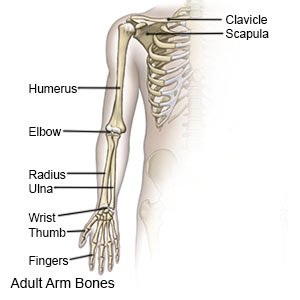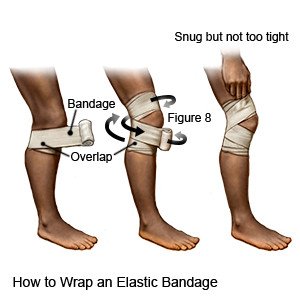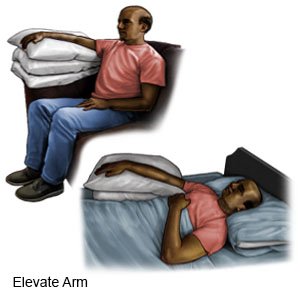Elbow Bursitis
Medically reviewed by Drugs.com. Last updated on Aug 4, 2025.
AMBULATORY CARE:
Elbow bursitis
is inflammation of the bursa in your elbow. The bursa is a fluid-filled sac that acts as a cushion between a bone and a tendon. A tendon is a cord of strong tissue that connects muscles to bones. The bursa is located right under the point of your elbow.
 |
Common signs and symptoms of elbow bursitis:
- Pain or tenderness when you touch or move your elbow
- Redness or swelling on or around the point of your elbow
- Decreased movement of your elbow
- Warmth of the skin over your elbow
- A grating or grinding sound or feeling when you move your elbow
Call your doctor if:
- Your pain and swelling increase.
- Your symptoms do not improve after 10 days of treatment.
- You have a fever.
- You have questions or concerns about your condition or care.
Related medications
Treatment
may include any of the following:
- Medicines:
- NSAIDs , such as ibuprofen, help decrease swelling, pain, and fever. NSAIDs can cause stomach bleeding or kidney problems in certain people. If you take blood thinner medicine, always ask your healthcare provider if NSAIDs are safe for you. Always read the medicine label and follow directions.
- Aspirin helps relieve pain and swelling. Take aspirin exactly as directed by your healthcare provider.
- Antibiotics help fight an infection caused by bacteria.
- Steroids help decrease pain and swelling. Steroid injections are given directly into the painful area. Steroid pills may be given for a short time to relieve acute pain.
- Fluid aspiration is a procedure to remove fluid from the area. This may be done before you have a steroid injection.
- Surgery may be needed to remove your bursa or part of your elbow bone. Surgery is only done when other treatments do not work.
Treatment options
The following list of medications are related to or used in the treatment of this condition.
Manage elbow bursitis:
- Rest your elbow as much as possible to decrease pain and swelling. Slowly start to do more each day. Return to your daily activities as directed. Do not bend your elbow all the way or lift anything heavy while your elbow is healing. An occupational therapist can help you find ways to keep your elbow rested that will help with the type of work you do. For example, arm rests that do not touch the elbow can make it easier to work at a computer.
- Use an elbow pad while your elbow heals. An elbow pad will cushion and protect your elbow. Your healthcare provider can tell you the kind of elbow pad to use. He or she can also tell you how long to wear it each day, and for how many days to use it.
- Apply ice to help decrease swelling and pain. Use an ice pack, or put crushed ice in a plastic bag. Cover the bag with a towel before you place it on your elbow. Apply ice for 15 to 20 minutes, 3 to 4 times each day, as directed.
- Use compression to help decrease swelling. Healthcare providers may wrap your arm with tape or an elastic bandage. Loosen the elastic bandage if you start to lose feeling in your fingers.

- Elevate (raise) your elbow above the level of your heart as often as you can. This will help decrease swelling and pain. Prop your elbow on pillows or blankets to keep it elevated comfortably.

- Go to physical therapy, if directed. A physical therapist teaches you exercises to help improve movement and strength, and to decrease pain.
Prevent elbow bursitis:
- Avoid injury and pressure to your elbows. Wear elbow pads or protectors when you play sports. Do not lean on your elbows or clench your fists. Do not tightly grip small items, such as tools or pens.
- Stretch, warm up, and cool down. Always stretch and do warmup and cool-down exercises before and after you exercise. This will help loosen your muscles and decrease stress on your elbow. Rest between workouts.
Follow up with your doctor as directed:
Write down your questions so you remember to ask them during your visits.
© Copyright Merative 2025 Information is for End User's use only and may not be sold, redistributed or otherwise used for commercial purposes.
The above information is an educational aid only. It is not intended as medical advice for individual conditions or treatments. Talk to your doctor, nurse or pharmacist before following any medical regimen to see if it is safe and effective for you.
Learn more about Elbow Bursitis
Treatment options
Care guides
Symptoms and treatments
Further information
Always consult your healthcare provider to ensure the information displayed on this page applies to your personal circumstances.
